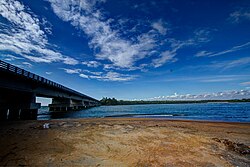| Kadalundi കടലുണ്ടി നദി | |
|---|---|
 Kadalundi bridge | |
 | |
| Location | |
| Country | India |
| State | Kerala |
| Districts | Palakkad, Malappuramand kozhikode |
| Physical characteristics | |
| Source | Cherakomban Mala |
| • location | Kerala, India |
| • coordinates | 11°08′N 76°28′E / 11.133°N 76.467°E |
| • elevation | 1,160 m (3,810 ft) |
| Mouth | Arabian Sea |
• location | Kerala, India |
• coordinates | 11°07′N 75°49′E / 11.117°N 75.817°E |
• elevation | 0 m (0 ft) |
| Length | 130 km (81 mi) |
| Basin size | 1,122 km2 (433 sq mi) |
| Discharge | |
| • location | mouth |
| • average | 36 m3/s (1,300 cu ft/s) |


Kadalundi River (Kadalundipuzha) is one of the four major rivers flowing through Malappuram district and kozhikode district in the Indian state of Kerala. The other three are the Chaliyar, the Bharathappuzha and the Tirur River.[1] This rain-fed river is 130 kilometres (81 mi) long and one of the most important rivers in the district.[2] Kadalundi River is also the sixth longest river in Kerala. Kadalundi River passes through [Karuvarakundu, Tuvvur [Melattur, Kerala|Melattur]], Pandikkad, Manjeri, Malappuram, Panakkad, Parappur, Vengara, Tirurangadi, Parappanangadi, Vallikkunnu, and empties itself into Arabian sea at Kadalundi Nagaram in Vallikkunnu on the northwestern border of the district.[3] It is formed by the confluence of the Olippuzha River and the Veliyar River.[3] The Kadalundi originates from the Western Ghats at the western border of the Silent Valley and flows through the district of Palakkad and Malappuram.[3] It has two main tributaries namely Olipuzha and Veliyar.[3] Olipuzha and Veliyar merges together to become Kadalundi River near Melattur.[3] Kadalundi River traverses through the historical regions of Eranad and Valluvanad.[3] The Kadalundi River drains an area of 1274 km2 and has a length of 120 km.[4] The ancient port of Tyndis, which was the second-largest trading port of Chera dynasty, only after to Muziris, is identified with the mouth of this river at Vallikunnu.[5] The Kadalundi Bird Sanctuary spreads over a cluster of islands where the Kadalundipuzha River flows into the Arabian Sea.[3] There are over a hundred species of native birds and around 60 species of migratory birds in large numbers annually.[6]
- ^ "Malappuram District Rivers". Malappuram.net. Retrieved 13 October 2006.
- ^ "Kerala Government - General Features". Official Website of Kerala Government. Archived from the original on 2 November 2006. Retrieved 13 October 2006.
- ^ a b c d e f g "Rivers in Malappuram district". malappuram.nic.in. Retrieved 23 November 2019.
- ^ NIC Malappuram website
- ^ A Survey of Kerala History, A. Shreedhara Menon
- ^ "Wild Life Tourism in Kerala". keralaeverything.com. Retrieved 13 October 2006.
